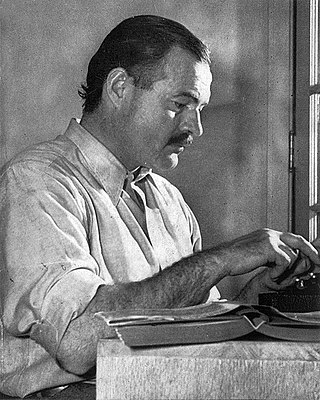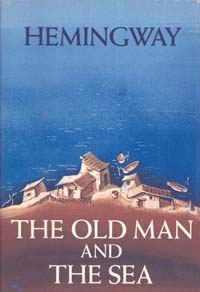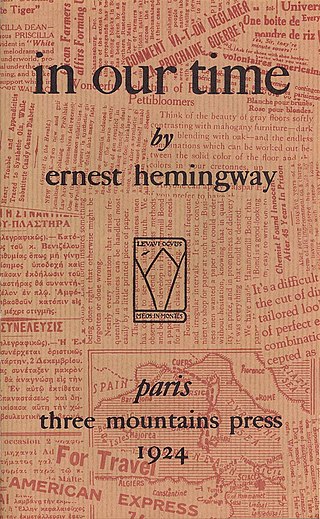
Ernest Miller Hemingway was an American novelist, short-story writer and journalist. Best known for an economical, understated style that significantly influenced later 20th-century writers, he is often romanticized for his adventurous lifestyle, and outspoken and blunt public image. Most of Hemingway's works were published between the mid-1920s and mid-1950s, including seven novels, six short-story collections and two non-fiction works. His writings have become classics of American literature; he was awarded the 1954 Nobel Prize in Literature, while three of his novels, four short-story collections and three nonfiction works were published posthumously.

Bay Township is a civil township of Charlevoix County, Michigan, United States. The population was 1,142 at the 2020 census.

The Old Man and the Sea is a 1952 novella written by the American author Ernest Hemingway. Written between December 1950 and February 1951, it was the last major fictional work Hemingway published during his lifetime. It tells the story of Santiago, an aging fisherman, and his long struggle to catch a giant marlin. The novella was highly anticipated and was released to record sales; the initial critical reception was equally positive, but attitudes have varied significantly since then.

In Our Time is the title of Ernest Hemingway's first collection of short stories, published in 1925 by Boni & Liveright, New York, and of a collection of vignettes published in 1924 in France titled in our time. Its title is derived from the English Book of Common Prayer, "Give peace in our time, O Lord".
Nicholas Adams is a fictional character, the protagonist of two dozen short stories and vignettes written in the 1920s and 1930s by American author Ernest Hemingway. Adams is partly inspired by Hemingway's own experiences, from his summers in Northern Michigan at his family cottage to his service in the Red Cross ambulance corps in World War I. The first of Hemingway's stories to feature Nick Adams was published in his 1925 collection In Our Time, with Adams appearing as a young child in "Indian Camp", the collection's first story.

Elizabeth Hadley Richardson was the first wife of American author Ernest Hemingway. The two married in 1921 after a courtship of less than a year, and moved to Paris within months of being married. In Paris, Hemingway pursued a writing career, and through him Richardson met other expatriate American and British writers.

The iceberg theory or theory of omission is a writing technique coined by American writer Ernest Hemingway. As a young journalist, Hemingway had to focus his newspaper reports on immediate events, with very little context or interpretation. When he became a writer of short stories, he retained this minimalistic style, focusing on surface elements without explicitly discussing underlying themes. Hemingway believed the deeper meaning of a story should not be evident on the surface, but should shine through implicitly.

Paul Scott Mowrer was an American newspaper correspondent.

Walloon Lake is an unincorporated community and census-designated place (CDP) in Charlevoix County in the U.S. state of Michigan. The population of the CDP was 271 at the 2020 census. The community is located within Melrose Township.

"The Three-Day Blow" is a short story written by Ernest Hemingway, published in the 1925 New York edition of In Our Time, by Boni & Liveright. The story is the fourth in the collection to feature Nick Adams, Hemingway's autobiographical alter ego.
"Up in Michigan" is a short story by American writer Ernest Hemingway, written in 1921 and revised in 1938. It is collected in Three Stories and Ten Poems (1923) and The Fifth Column and the First Forty-Nine Stories (1938).

"Indian Camp" is a short story written by Ernest Hemingway. The story was first published in 1924 in Ford Madox Ford's literary magazine Transatlantic Review in Paris and republished by Boni & Liveright in Hemingway's first American volume of short stories In Our Time in 1925. Hemingway's semi-autobiographical character Nick Adams—a child in this story—makes his first appearance in "Indian Camp", told from his point of view.

Horton Bay is an unincorporated community and census-designated place (CDP) in Charlevoix County in the U.S. state of Michigan. The population of the CDP was 485 at the 2020 census. The community is located within Bay Township on northeastern shores of Lake Charlevoix.

"The Doctor and the Doctor's Wife" is a short story by Ernest Hemingway, published in the 1925 New York edition of In Our Time, by Boni & Liveright. The story is the second in the collection to feature Nick Adams, Hemingway's autobiographical alter ego. "The Doctor and the Doctor's Wife" follows "Indian Camp" in the collection, includes elements of the same style and themes, yet is written in counterpoint to the first story.
"On Writing" is a story fragment written by Ernest Hemingway which he omitted from the end of his short story, "Big Two-Hearted River", when it was published in 1925 in In Our Time. It was then published after Hemingway's death in the 1972 collection The Nick Adams Stories.

"The Revolutionist" is an Ernest Hemingway short story published in his first American volume of stories In Our Time. Originally written as a vignette for his earlier Paris edition of the collection, titled in our time, he rewrote and expanded the piece for the 1925 American edition published by Boni & Liveright. It is only one of two vignettes rewritten as short stories for the American edition.

"My Old Man" is a short story written by Ernest Hemingway, published in his 1923 book Three Stories and Ten Poems, which published by a small Paris imprint. The story was also included in his next collection of stories, In Our Time, published in New York in 1925 by Boni & Liveright. The story tells of a boy named Joe whose father is a steeplechase jockey, and is narrated from Joe's point-of-view.

"Out of Season" is a short story written by Ernest Hemingway, first published in 1923 in Paris in the privately printed book, Three Stories and Ten Poems. It was included in his next collection of stories, In Our Time, published in New York in 1925 by Boni & Liveright. Set in Cortina d'Ampezzo, Italy, the story is about an expatriate American husband and wife who spend the day fishing, with a local guide. Critical attention focuses chiefly on its autobiographical elements and on Hemingway's claim that it was his first attempt at using the "theory of omission".

The Horton Bay General Store is a commercial building located at 05115 Boyne City Road in Horton Bay, Michigan. It was listed in the National Register of Historic Places in 1991. The store is mentioned in two of Ernest Hemingway's short stories, "Up in Michigan" and "The Last Good Country."
The Red Fox Inn, also known as the Horton Bay House, is a building, originally, a boardinghouse, located at 05156 Boyne City Road in Horton Bay, Michigan. It was listed in the National Register of Historic Places in 1995. The inn is mentioned in Ernest Hemingway's short story, "Up in Michigan," and tradition has it that the inn's proprietor during the 1910s and 20s, Vollie Fox, taught Hemingway how to fish.










